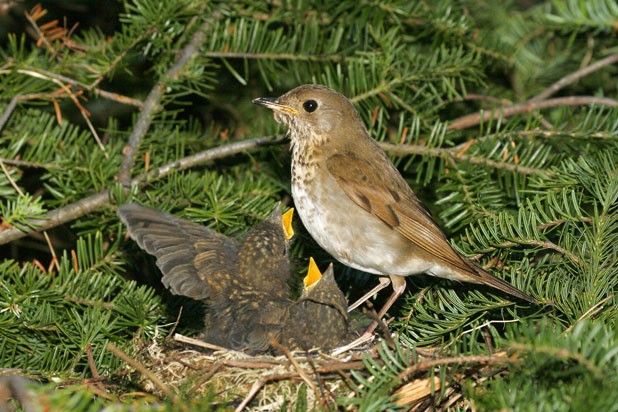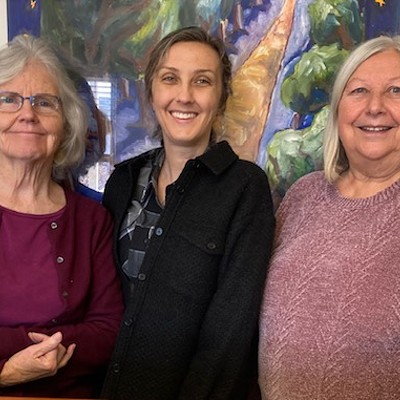
It's 3:30 a.m. on the summit of Stratton Mountain. The sun won't rise for another two hours, but scientists from the Vermont Center for Ecostudies (VCE) have already begun their search for "the canary of the mountains," more commonly known as Bicknell's Thrush.
While their coffee percolates inside the Ski Patrol hut, VCE field directors Sara Frey and her husband Juan Klavins open mist nets around Stratton's high-elevation trails to catch the rare bird, which breeds only in the montane fir forests of the U.S. Northeast and parts of the Gaspé Peninsula in Québec.
Frey and Klavins, along with a field technician and a project intern from the University of Vermont, have shared this Balsam fir habitat with the Bicknell's Thrush for the better part of six weeks, collecting blood samples, banding the birds and finding their nests using radio telemetry.
"This work is difficult," admits Frey, who sleeps in the bed of her Toyota pickup at night with Klavins. The research team has endured varying weather, black flies and little sleep for weeks on the summit. But as scientists who study a bird facing imminent extinction from climate change, the conservation of Bicknell's takes priority over their own discomfort.
"[Bicknell's] are very secretive," Frey says, "and it takes patience to study their behavior, when you can look at one."
Frey says she became "hooked" on Bicknell's research in 2003 when she got involved with an ongoing ecological and demographic study of the bird. Because their breeding habitat exists only in these mountainous regions, which VCE biologists say exaggerates problems such as climate change and atmospheric deposition of mercury, the Bicknell's is at risk of losing its habitat and ultimately the entire species.
"It is a species that is so closely associated with a specific habitat - montane forests of the Northeast - that it can not only help us understand how to direct conservation of Bicknell's Thrush but the ecosystem as a whole," says Frey, who has been working with Woodstock-based Kent McFarland, a VCE conservation biologist who joined the Bicknell's research in 1994.
With help from biologists such as Frey and citizen scientists - trained volunteers - McFarland and his colleagues have collected extensive data on Bicknell's Thrush and their diminishing habitats. Their most recent work was included in the peer-reviewed paper "Potential Effects of Climate Change on Birds of the Northeast," published in April in Mitigation and Adaptation Strategies for Climate Change.
In the paper, McFarland and fellow biologist Dan Lambert from the American Bird Conservancy predict that the current pace of carbon dioxide emissions will raise temperatures enough to produce major population declines in high-elevation birds like the Bicknell's. With only about 40,000 of them left, there's reason to worry, says McFarland, who has accompanied Frey and the research team on the summit for the day.
Using computer-simulated warming, the duo found that raising the mean summer temperature by 1 degree Celsius would reduce the availability of suitable Balsam fir habitat for the Bicknell's by more than half. An increase of 2 degrees, expected before the next century, would eliminate all breeding sites in the Catskills and most in the Green Mountains.
"Bicknell's are so tied to this Balsam fir forest that they don't seem to have much plasticity to go to another forest type," McFarland says, pointing to digital maps of the species' "richness" on his laptop while he sits in the cluttered Ski Patrol hut. "Its ability to change that rapidly or adapt that rapidly would surprise me."
The team has just returned from a net run in which they pulled a Bicknell's Thrush from the tangles of a mist net. The net is made of thin nylon and is virtually invisible. A partnering biologist from the Dominican Republic, the Bicknell's thrush wintering grounds, holds the olive-brown bird as it flutters in his hands and gives a slurred whistle. This particular Bicknell's was banded by the VCE "almost a year ago to the day," McFarland says.
After updating the bird's data, Pat Johnson, the team's field technician, returns the bird to its nesting area then checks on its nest, dubbed "stumpy" - a tight bed of twigs and fungus tucked into a mangled stump deep within the forest.
These forests, McFarland explains, adapted to a slow warming period nearly 3500 years ago by moving to higher elevations. That took more than a thousand years. Considering the current carbon emission scenarios issued by the Intergovernmental Panel on Climate Change, McFarland isn't expecting a repeat of that leisurely adaptation.
"I will die and there will still be Bicknell's Thrush," he says. "My daughter? Not so sure. My daughter's daughter? There probably will not be Bicknell's Thrush if climate change continues as predicted. I don't know if trees can react that fast. This [current] warming is going to happen in 150 to 200 years. It's a totally different beast. The forest zones will literally lose ground."
To make matters worse, the VCE is now saying that Bicknell's and other high-elevation birds are susceptible to the atmospheric deposition of mercury as well. The same coal-burning plants emitting carbon and contributing to global warming are dumping mercury on the mountain peaks of the Northeast.
McFarland says mercury deposition maps of the Northeast encompass the Bicknell's Thrush habitats. The mercury works its way up the food chain: The Bicknell's Thrush eats leaf-eating insects, and the Sharp Shinned Hawk eats Bicknell's. While the biologists at VCE aren't certain of mercury's effects on the birds, their speculations aren't positive.
"We're the tail pipe of the nation," explains McFarland, as VCE Director Chris Rimmer extracts a blood sample from a Sharp Shinned Hawk to test for its mercury count. "Mercury from the Ohio Valley is transported and comes to us in rain and snow, and a lot of it gets wicked out in the needles of the high-elevation trees."
******
The Dummerston office of avian ecologist Hector Galbraith lies roughly 30 miles southeast of where the Vermont Center for Ecostudies researched the Bicknell's Thrush.
Galbraith is also the director of the Climate Change and Energy Initiative at the Manomet Center for Conservation Sciences in Massachusetts. In a phone conversation, Galbraith says the organization should become a model for state and private research organizations in the coming decades.
"This is the exact sort of research we need to be doing to track these birds in real time and deal with climate change, because Bicknell's are so exquisitely sensitive and vulnerable to climate change," he says. "Their thermal habitat may very well go before the fir forest [does]."
Galbraith notes Bicknell's and their habitat will need to move up 900 feet, but they don't have 900 feet to move. "Whatever way you look at it, this is not good news for Bicknell's Thrush," he says.
Despite its diminishing habitat and susceptibility to mercury deposition, among other effects jeopardizing the species' demography, it is not listed as "endangered" or "threatened" by the U.S. Fish and Wildlife Service (USFWS).
USFWS Spokesperson Valerie Fellows says research grants are typically prioritized by species depending on their endangered or threatened status at the federal and state level. In the 2007 fiscal year, USFWS' National Wildlife Refuge System provided VCE with $16,062 for its work with Bicknell's Thrush; in 2008, it was just $3600. Vermont Fish & Wildlife and private foundations brought the annual funding for this project to about $100,000.
"We have got to get real about funding these long-term monitoring studies," protests Galbraith. "We are heading for major ecological change. Climate change is not just a thing of the future, it's happening now.
"Even at first glance it's obvious that the species is fragmented," he continues. "It has a small population with limited distribution in the U.S. and its habitat is quite vulnerable. With that said, there have been a lot of petitioned candidates recently but few actual listings."
Waiting out the political climate in Washington, the VCE is focusing on saving their feathered friend, and has spearheaded the formation of the International Group for Bicknell's Thrush Conservation. "We'd like to get the bird on a corrective course and we needed a formal entity," McFarland explains. "In the end, we'll have a road map for Bicknell's Thrush habitat: Here's the problem, here's the solution, and here's how we're going to do it."
******
Meanwhile, the field season is about to end atop Stratton. The team has ingested enough Thai noodles, bean burritos and Yerba Maté to tide them over until next summer, but as they pack up their gear, they've got something new to ponder: a Bicknell's-Veery hybrid.
Frey, who has kept a blog while on the mountain, mentions the discovery in her June 20 post: "This bird sang a slightly odd Veery song and then about every 3rd song it sang a short Veery song that ended abruptly and broke into the ending of a Bicknell's thrush song! We quickly captured it in a mist net playing its own song back to itself."
VCE has planned to run DNA tests on the bird to find out whether the mother is Bicknell's or Veery, says McFarland. The hybrid is not necessarily an indication of climate change, as recently reported.
"Veery is very nearby Bicknell's Thrush habitat and they are closely related," he says. "It is just interesting to find. Now, if it began to occur more and more, then it might be interesting to understand why. Hybrids occur among organisms all the time."
It's now after 11 a.m. The team takes down the mist nets. McFarland stuffs his pockets with the nylon and carries the netting poles over his shoulder, cracking jokes at Rimmer's expense. "We have fun too," he admits.
McFarland takes a moment to rest inside the hut. Tugging on the binoculars strapped around his long-sleeved flannel, he glances out the window.
"I'm not necessarily a religious person, but I sort of find my mystery in life in things like Bicknell's Thrush," he muses. "I would be really sad if they go. These are like great works of art. You're not going to recreate them again."










Comments
Comments are closed.
From 2014-2020, Seven Days allowed readers to comment on all stories posted on our website. While we've appreciated the suggestions and insights, right now Seven Days is prioritizing our core mission — producing high-quality, responsible local journalism — over moderating online debates between readers.
To criticize, correct or praise our reporting, please send us a letter to the editor or send us a tip. We’ll check it out and report the results.
Online comments may return when we have better tech tools for managing them. Thanks for reading.